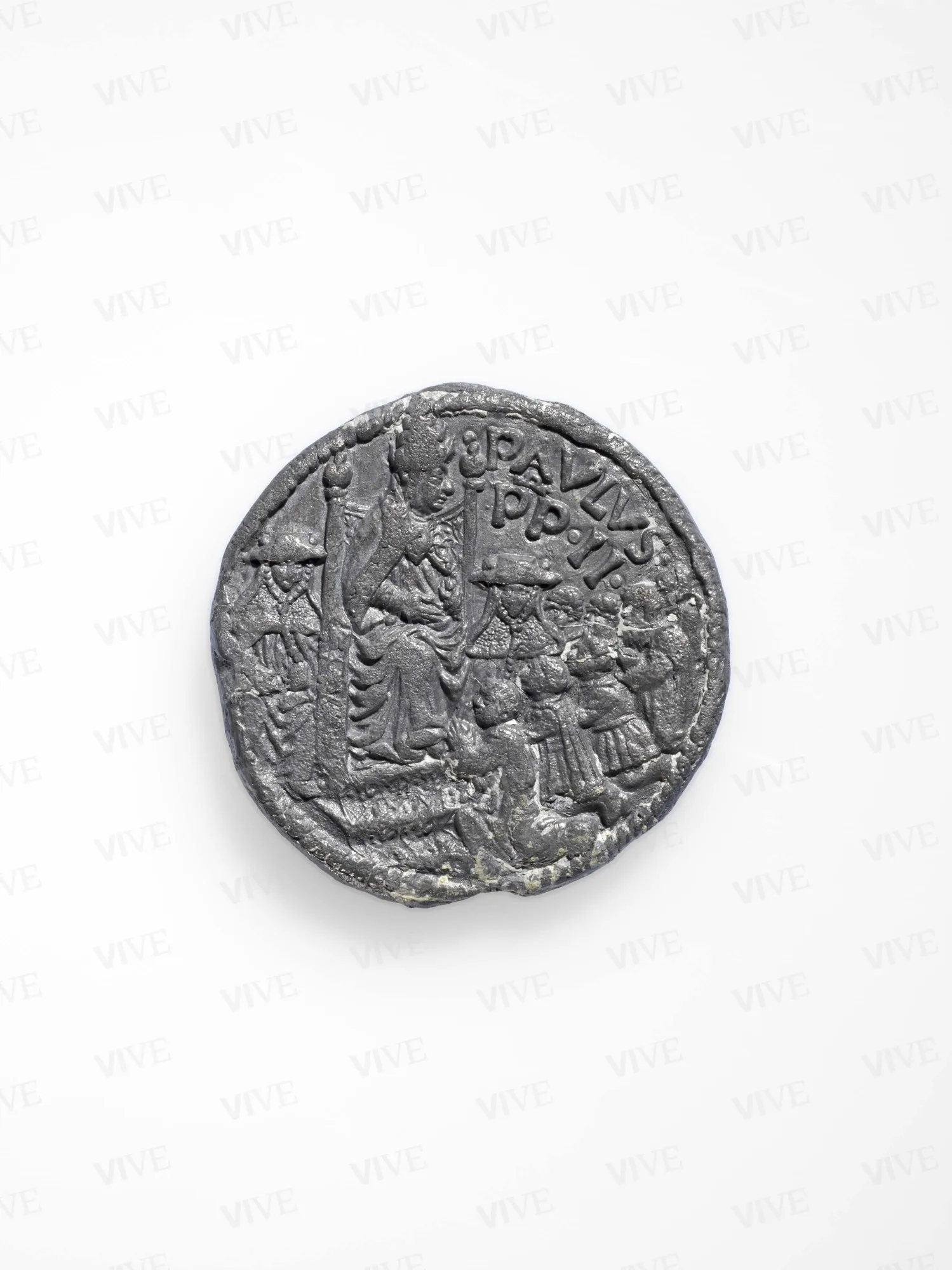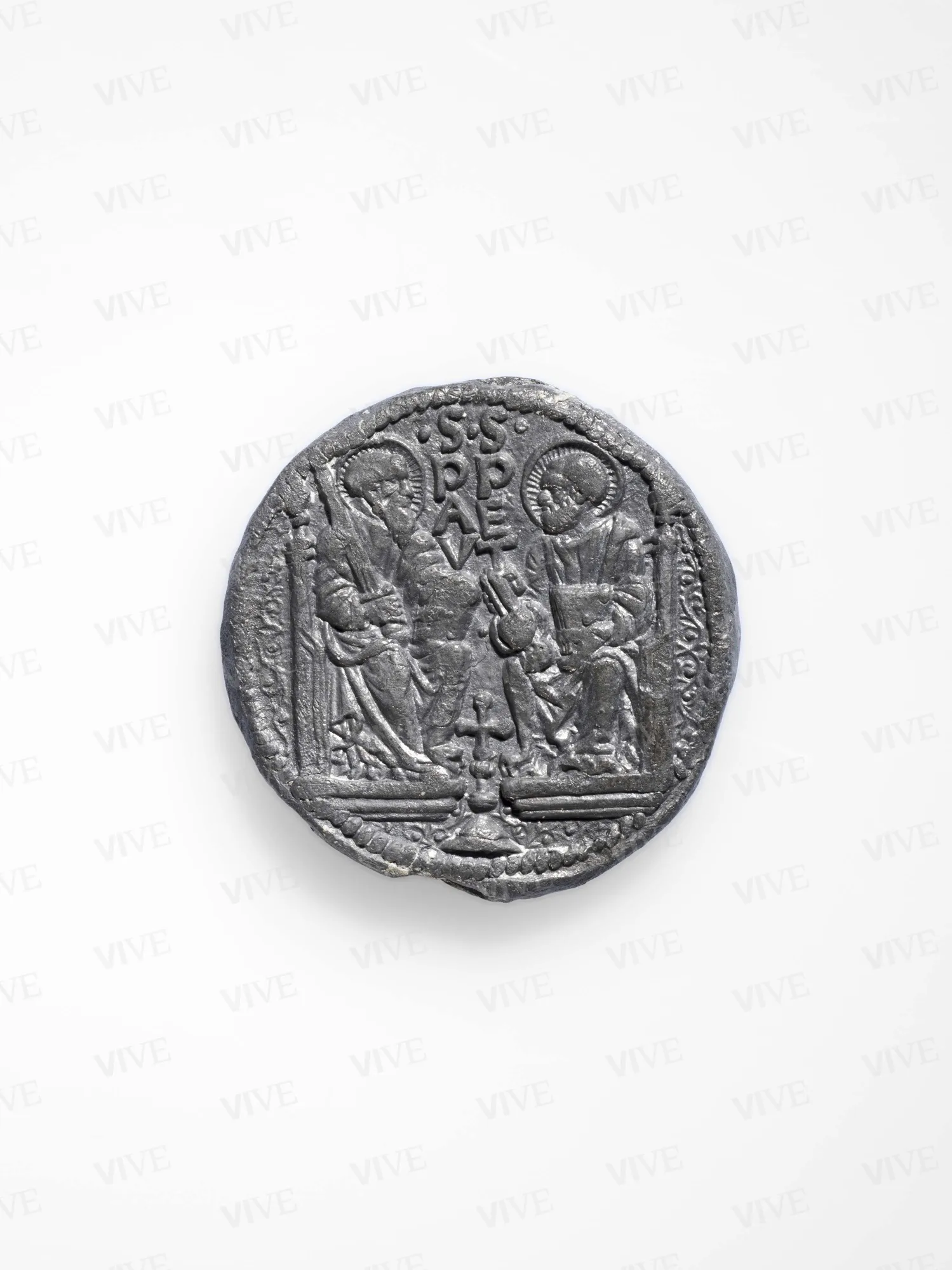Pope Paul II’s Bulla
Emiliano Orfini 1465
The leaden bulla of Pope Paul II was used to authenticate pontifical decrees on which it was stamped. It was created by Emiliano Orfini from Foligno, likely around 1465. The obverse appears to depict the children of the recently deceased Emperor of the East, Thomas Palaiologos, requesting an annuity from the Pope to support themselves in Rome, where they had been residing for several years.
The leaden bulla of Pope Paul II was used to authenticate pontifical decrees on which it was stamped. It was created by Emiliano Orfini from Foligno, likely around 1465. The obverse appears to depict the children of the recently deceased Emperor of the East, Thomas Palaiologos, requesting an annuity from the Pope to support themselves in Rome, where they had been residing for several years.
Details of work
Catalog entry
This small leaden object is a seal utilized by the pope to authenticate his edicts, which are referred to as papal bullae. Typically, these bullae were affixed to parchments containing the texts of decrees through a cord that passed longitudinally through the perforated metal disc. While many seals remain attached to their original documents, numerous seals have been lost or repurposed for other uses of the metal (Bautier 1992).
Unlike the popes who preceded and followed him, who had a standard model of a bulla with the faces of Saints Peter and Paul on one side and the pope’s name alone on the other, Pope Paul II, in office from 1464, instructed his engraver Emiliano Orfini to create a different and more elaborate bulla, reflecting his interest in numismatics and commemorating his pontificate.
The obverse of the bulla features a full-length portrait of Pope Paul II, whose face, despite being only a few millimeters high, is clearly recognizable. He is depicted wearing the triple crown and an ornate cope fastened at the chest by a jeweled button. The Pope is seated on a throne elevated two steps above the floor, accompanied by two cardinals identifiable by the large galeri framing their faces. Kneeling before him are three young men with joined hands in a gesture of supplication, accompanied by a bearded figure (Hill 1910, p. 359).
Conversely, the reverse maintains the traditional iconography of Peter and Paul but modifies their representation. Instead of illustrating their faces alone, it depicts the entire figures of the two saints, adorned with halos and seated on thrones facing each other, holding swords, keys, and books. In the center, extending from the exergue, there is a processional cross mounted on a conical base.
The bulla is not dated, but the scene on the obverse is connected to an event in the pontiff's life from 1465. On 12 May of that year, Thomas Palaiologos died. He had been the Despot of the Morea until its Turkish conquest in 1460, after which he moved to Rome with his family, where he was acknowledged as the legitimate emperor of Byzantium and converted to Catholicism (Ostrogorsky 1993, pp. 500–510). At the time of his death, his eldest son, Andrew Palaiologos, was ten years old, and Paul II took responsibility for their financial support, providing an annuity of 300 florins a month (Buonanni 1699, pp. 82–83, n. VIII; Modesti 2002, p. 263, n. 94). In 1472, he arranged the marriage of Andrew's sister Zoe to Ivan III of Russia with the aim of converting Russia to Catholicism. The depiction of three kneeling boys on the bulla has led to interpretations suggesting this scene represents the moment the young Palaiologos appealed to the pontiff shortly after their father's death, in the latter half of 1465.
Technically, the bulla was created by engraving a metal matrix, pressing wax into it to produce models, which were then cast in metal.
Emiliano Orfini, born in Foligno to a family of goldsmiths and printers, held the position of papal mintsman in Spoleto prior to relocating to Rome. Records indicate his presence in Rome from 1464 onwards, where he secured a contract for the papal mint starting in 1471, lasting at least five years. In addition to his duties of engraving dies and seals for the pontiff, Orfini was involved in producing movable type for printing. Several incunabula bearing his name remain preserved (Scapecchi 2013).
Giulia Zaccariotto
Entry published on 27 March 2025
State of conservation
Good.
Restorations and analyses
The seal exhibited typical oxidation, commonly referred to as lead corrosion, caused by humidity. It has been restored as of July 2022 and subsequently protected with microcrystalline wax to prevent future occurrences of the issue.
Inscriptions
Obverse: in the field, within a wainscoted border, “• PAVLVS • / • P[a]P[a] • II”;
Reverse: in the field, within a wainscoted border, “• S[anctus] PAVLVS • S[anctus] PET[rus] •”
Provenance
Purchased from Castel Sant’Angelo, February 27, 1937.
References
Buonanni Filippo, Numismata Pontificum Romanorum quae a tempore Martini V usque ad annum MDCXCIX vel authoritate publica, vel privato genio in lucem prodiere, Romae 1699;
Hill George Francis, The Medals of Paul II, in «Numismatic Chronicle», s. 4, X, 1910, pp. 340-369;
Bautier Robert Henri, Bolla, ad vocem, in Enciclopedia dell’Arte Medievale, Roma 1992.
Ostrogorsky Georg, Storia dell’impero bizantino, Torino 1993;
Modesti Adolfo, Corpus numismatum omnium Romanorum Pontificum. Volume I. Da San Pietro (42-67) a Adriano VI (1522-1523), Roma 2002;
Scapecchi Piero, Emiliano Orfini, ad vocem, in Dizionario Biografico degli Italiani, LXXIX, Roma 2013.














